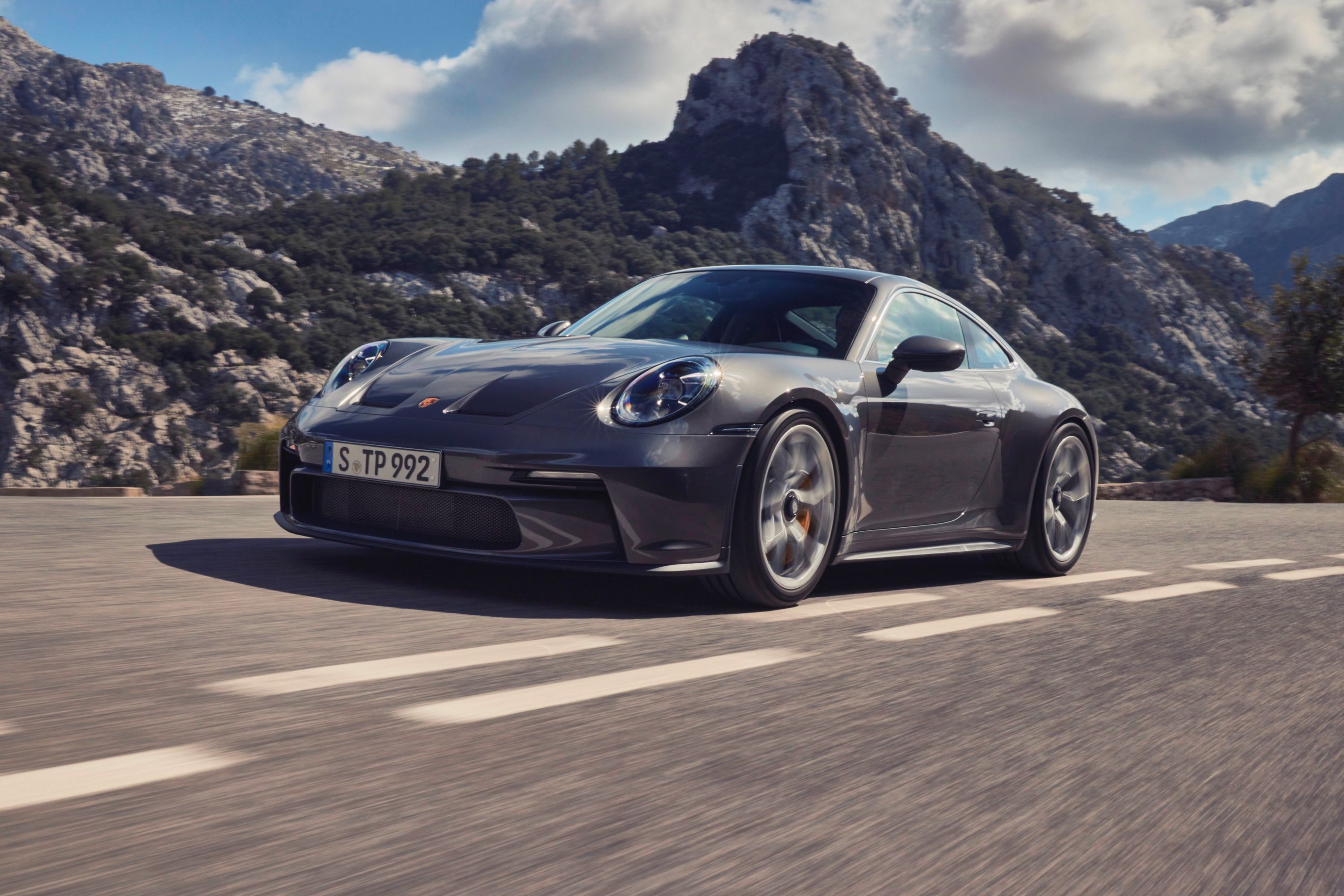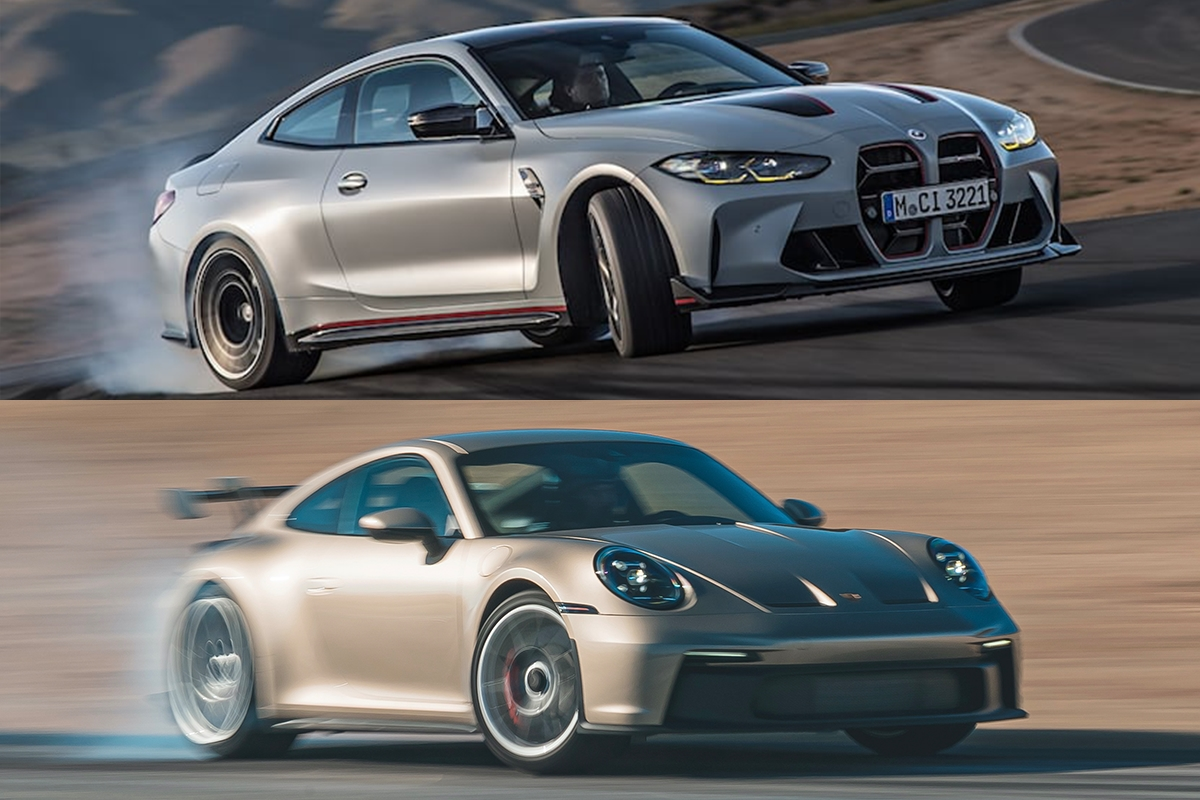
For good reason, BMW doesn't simply slap a CSL badge onto the back of anything. The hallowed badge signifies a high-performance BMW that has been stripped of everyday comforts to save weight in the pursuit of unrivaled precision and performance on the track. The E46 M3 CSL was one of BMW M's finest accomplishments, but other than filling those legendary shoes, can the new M4 CSL match the breathtaking Porsche 911 GT3?
Whereas the 911 GT3 has the benefit of being based on the already magnificent 911 sports car, BMW's starting point is essentially a much more mundane 4 Series luxury coupe. To compete, BMW tossed the M4's back seats, added more power, tweaked the suspension, and gave it a total aerodynamic makeover. Can it match the mighty GT3 on paper? Let's find out.
Exterior: Aggressively Different
Both the M4 CSL and 911 GT3 are immediately distinguishable from the ordinary 4 Series and 911. Each automaker has paid close attention to aerodynamics while seeking to give these track monsters a brasher personality. The two cars we end up with couldn't be more different, though. The BMW has a giant grille highlighted by red trim, whereas the GT3's face is quite subtle by comparison, with extra openings on the hood. Whereas the Porsche has a fixed rear wing with a swan-neck mounting (a GT3 Touring is available without this wing), the BMW settles for a ducktail trunk spoiler. Centrally-mounted tailpipes for the GT3 are contrasted by quad tailpipes - two on each side - for the CSL.
The BMW's more traditional coupe silhouette with a separate trunk is markedly different from the Porsche's truncated rear end and smoother roofline. Other changes for the BMW include forged M light alloy wheels (19 inches in front and 20s at the back); a CFRP grille; carbon for parts like the hood, roof, and trunk lid; and yellow daytime running lights. The Porsche has larger 20-/21-inch wheels and a special front apron with extra air openings.
Most will find the GT3 more pleasing to the eye, but we'd argue that the CSL's makeover is more attention-grabbing - for better or worse.
Interior: More Sport, Less Luxury
With their racing genes, both cars have sporty interiors that place the focus on the driver. There are no back seats to speak of, saving weight but eliminating the possibility of traveling with more than one passenger. Everywhere you look, you'll see bits of Alcantara and carbon fiber, although BMW includes a lot of the carbon fiber trim as standard whereas Porsche charges extra.
The BMW M4 CSL comes with carbon-shelled M full bucket seats that hold you firmly in place and save over 50 pounds compared to regular 4 Series seats. Red stitching lifts the predominantly dark environment, there is a red 12 o'clock marker, and a plethora of CSL badges. A rear cargo net replaces the rear seat and provides a perfect place to store two racing helmets.
In the Porsche, a sporty mix of Race-Tex/leather upholstery and a GT3 sport steering wheel set the scene, but you'll need to spend more money to get the lightweight carbon fiber seats. Both automakers do a good job of placing the major controls where you expect to find them, but the Porsche's lower seating position is a touch sportier.
Despite all the racy touches, these are still modern German coupes so touchscreen interfaces and fully functional climate control systems mean that you need not be uncomfortable on your way to the track.
As for which is better, it's a tough call. Forward visibility in the 911 will be better by virtue of its engine being behind you, but the carbon seats in the M4 CSL and tons of weight-saving look mighty attractive.
Performance & Powertrains: Similar Philosophies, Blinding Results
In a straight line, the GT3 is not the fastest 911 and the CSL is not the fastest M4. Both Porsche and BMW know that to create a pure, stripped-down performance machine that is a blast on the track, some compromises had to be made. That means that neither car has a heavy all-wheel-drive system, and explains why the 911 Turbo and M4 Competition xDrive are quicker to 60 mph.
The BMW uses the brand's potent S58 3.0-liter six-cylinder turbocharged engine, tuned here to deliver 543 horsepower and 479 lb-ft of torque. Sending all that power to the rear wheels only via a uniquely tuned eight-speed automatic transmission, the M4 CSL reaches 60 mph in 3.6 seconds, 120 mph in 10.5, and a top speed of 191 mph. If straight-line speed matters to you, the Porsche wins - at least when equipped with the automatic.
The GT3's 4.0-liter naturally-aspirated boxer-six engine makes 502 hp and 346 lb-ft. Also RWD, the GT3 with the six-speed manual takes 3.7 seconds to hit 60 before reaching a heady top speed of 199 mph. With the seven-speed PDK dual-clutch automatic, the GT3 can do the same sprint in 3.2 seconds, but the top speed drops to 197 mph.
Weight is a factor in favor of the GT3. The manual weighs just 3,126 pounds, whereas the M4 CSL weighs 3,640 lbs. With the PDK, the Porsche remains significantly lighter at 3,164 lbs. And, as charismatic as the CSL's engine can be, the GT3 sounds even better as you work it up to its 9,000-rpm redline.
Until we drive these two cars back to back, we can't say for certain that the GT3 will be more fun and agile than the CSL, but it's likely. Porsche has tuned the GT3's electric steering to perfection, the 911's balance is inherently superb, and grip levels are astonishingly high. Crucially, both GT3 transmissions are more engaging than a conventional automatic could ever be, even one as good as the eight-speed ZF in the BMW.
None of this means that the M4 CSL will be anything less than thrilling. After all, BMW showed us how dramatically it could alter a car's personality when the M5 CS came out after the regular M5. The new M4 CSL has a lower ride height, model-specific steering, and bespoke suspension tuning. There are standard carbon-ceramic brakes that will undoubtedly be up to the challenge on the track.
At 7 minutes and 20.2 seconds around the Nurburgring, the M4 CSL was quicker around the circuit than any other series-production BMW before it. It can't hold a candle to the GT3, though - the Porsche conquered the Green Hell in 6 minutes and 55.34 seconds, a phenomenal effort. At the end of the day, it's safe to say that BMW and Porsche squeezed as much as they could out of the 4 Series/911 platforms with these track monsters.
Pricing & Verdict: Porsche Edges It… For Now
At $139,900, the new M4 CSL is almost twice the price of the normal M4. That's a lot of money for a BMW sports coupe, but this is no ordinary M4. Inside and out, BMW's M division has built something special. The old M3 CSL's high price for the relatively small performance gain was often spoken about, but that car was so thrilling to drive that it didn't matter. We expect much the same with this new M4 CSL, which is limited to just 1,000 examples.
At $161,100, the Porsche 911 GT3 is even more expensive. Besides that, you'll have to cough up over $9,000 for carbon-ceramic brakes (standard on the BMW) and there are countless other expensive options without the Bimmer's exclusivity. Still, based on this early evidence, the GT3 looks to have retained its edge. It's easily quicker on a track, the engine is a marvel, and that dual-clutch gearbox is one of the best.
A first drive in the new M4 CSL will be needed to settle this one with absolute certainty, but if you find yourself in the privileged position of having to choose between these two cars, you can hardly make a bad decision either way.

